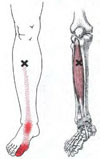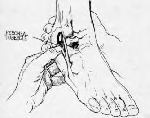|
Return to Articles Main Page
Introduction:
Tendonitis is inflammation of a tendon (the cord-like structure that connects muscle to bone). Tendonitis (also spelled tendinitis) can occur in the foot and ankle. Causes are usually overuse of the muscle with increased, repetitive or excessive exercising. It also can be caused by weight gain or inactivity, shoes that are worn out to one side or foot deformities like flatfeet or rigid high arched feet.
Tendons under excessive strain will begin to cause the outer covering of the tendon to swell or develop small tears. Tendonitis can start out with episodic pain, but with continued use of the part, the tendon will be painful whenever it is used.
There are four major tendons in the foot and ankle that commonly are involved. Each will be discussed briefly.
Achilles Tendonitis:
This affects the large tendon that connects the calf muscles to the back of the heel. Pain will usually occur as you lift your heel off the ground while walking or when going up steps. This condition may be associated with bursitis (inflammation of the soft tissue in the back of the heel) or a “pump bump” (an enlargement of bone that rubs against the back of your shoe). |

|

|
Posterior Tibial Tendonitis:
This affects the tendon that inserts under the arch and helps hold it up. Pain under the arch will be felt when you push off to take a step. People with flatfeet are affected the most. Overweight women are prone to this tendonitis as well. It is not uncommon for an injury to partially tear this tendon sheath which easily becomes a chronic problem. |
Anterior Tibial Tendonitis:
This affects the main tendon on the front of the ankle that lifts your foot during gait. Pain is felt in the instep when going down stairs or downhill. This tendonitis is also associated with stop and start sports like tennis. |

|

|
Peroneal Tendonitis:
This affects the tendon on the outer portion of your ankle and foot.
Pain will be felt with standing or when pushing off to take a step. This condition is almost always created by injury. |
Symptoms:
When presenting to the podiatrist’s office the doctor may question you about your shoes, what type of activities are painful, and your general health. During the exam the doctor may take x rays to look for a stress fracture or other problems of the bones. In certain cases the doctor may order an MRI (magnetic resonance image) to evaluate the tendon for tears or tenosynovitis (inflammation of the tendon sheath).
Treatment:
Tendonitis is readily treatable with rest or change of activity to a non-impact sport like swimming or bicycling. Ice should be used when symptoms begin. Heat may be used after a few days. Your doctor will usually prescribe an anti-inflammatory medicine that should be taken exactly as prescribed. In some cases the doctor may inject the tendon sheath with medicine (cortisone) to reduce inflammation except in the case of Achilles tendonitis where injections are to be avoided.
The doctor may prescribe a heel lift or orthotic to optimally position your foot to reduce tendon strain (see previous topic of the month). Your doctor may also refer you to a physical therapist for treatment. Some severe cases of tendonitis will require immobilization with a below the knee cast for a period of 2-4 weeks. Finally, surgery may be performed to repair partial or complete tears in the tendon or to address severe tenosynovitis.
Return to Articles Main Page
Our Services | Referring Physicians | About Us | Frequently Asked Questions | Blog | Articles
Surgical Animations | Links | News & Press | Photo Gallery
Contact Us | Home | Legal Notice | Privacy Statement | Site Map
Copyright © Buffalo Medical Group P.C. / Podiatry Affiliates
Website Design, Maintenance and Hosting by Catalyst Marketing / Worry Free Websites |
